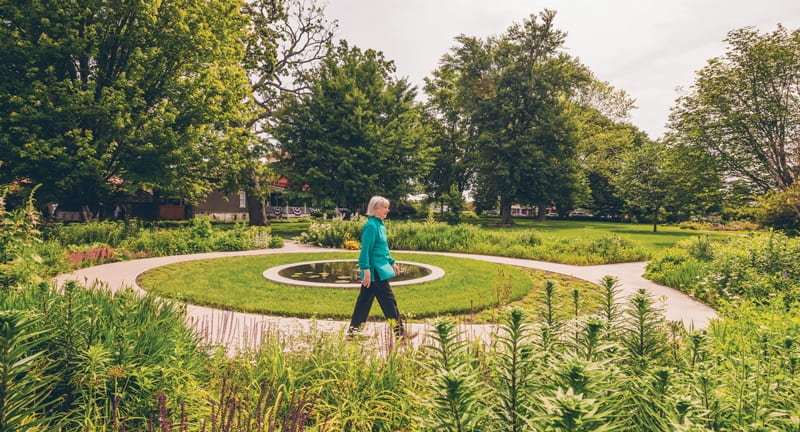In Nature By Design
Butterfield resident Karen Crocker remembers the summers of her teen years. Her family had a cabin in Inverness, California, along what is now the Point Reyes National Seashore. They enjoyed hiking, swimming, sailing – and simply being in nature.
It was about an hour from where she grew up in Berkeley. Her dad had studied forestry and
then became a mammalogist; her mom was a modern dancer.
For Crocker and her twin sister, Susan, their summers in nature greatly influenced their careers. Crocker is a landscape architect and garden design expert, and a retired University of Arkansas professor. Her sister is a marine biologist.
Crocker, in fact, has helped develop some of the area’s most treasured garden projects: the Peel Museum and Botanical Garden and Compton Gardens among them. Now retired, Crocker chairs BTV’s Landscape and Gardening Committee, and continues lending her time and expertise to community garden projects in the region.
“I’ve had an unparalleled opportunity to be part of design teams that created the Peel gardens and Compton Gardens, which enhance the lives of the people who gather there and who pass through,” Crocker said. “I feel very lucky to have been involved, and to see these landscapes continue to be well-maintained, meaningful parts of Northwest Arkansas history.”

Karen and Thermon Crocker at Compton Gardens
Designing Her Destiny
After attending college in southern California, Crocker studied dance at NYU, but it wasn’t the right fit. One day in a Greenwich Village bookstore, she found the 1969 book Design With Nature by Ian McHarg, who pioneered the idea of incorporating and preserving natural spaces in cities through land-use planning.
“I read that book and I said, ‘That’s what I want to do,’” Crocker said.
Crocker earned a Masters of Landscape Architecture degree at the University of Michigan, while raising two young daughters. Her thesis about small-town design caught the eye of the University of Arkansas hiring committee when she applied for a landscape architecture teaching position. UA architecture professor Frank Burggraf hired her in 1985. She and Burggraf later worked studying Civilian Conservation Corps land-improvement projects at three Arkansas State Parks: Devil’s Den, Mount Nebo and Petit Jean.
At U of A, Crocker taught landscape architecture and urban design, and was one of just a few female faculty members in the School of Architecture. Her students created urban design projects in Siloam Springs and Fort Smith, and a pavilion and trail for a downtown Helena park.

At Peel Museum and Botanical Garden
A Natural Calling
Through a colleague, Crocker got involved with Peel House Foundation, comprising the Peel mansion and grounds in Bentonville. Built in 1875 for Col. Samuel Peel’s family, the Italianate style mansion was in bad shape and overrun with wisteria, but it was being restored, along with the three acres of property.
“So the question was, what to do with the grounds,” she said.
Rather than formal gardens that might be expected with a mansion, it once had vegetable gardens, flowers and a 180-acre apple orchard. In 1994, Crocker and Bob Byers, another landscape architect, recommended designs for the grounds based on the Victorian patterns popularized by Andrew Jackson Downing, an early 1800s landscape designer and writer. The plan was to develop a perennial garden, rose garden, shaded native garden, and a pioneer vegetable and herb garden. A Victorian children’s garden came later.
They also stumbled upon a valuable resource for sourcing plants. From 1836 to the 1870s, a Fayetteville nurseryman documented the plants and weather conditions on his 25 acres on Scull Creek. This told them what types of plants grew in the region then.
Crocker still has her design sketch for the garden rose trellis – a series of thin, overlapping arches with two oval shapes. She knew pipe would last longer than wood, so she found a local pipe company owner who welded the pieces together.
Their garden design won a Merit Award from the Arkansas chapter of the American Society of Landscape Architects in 1998.
Crocker also served on the Peel House board for many years and was involved with fundraisers, tours and other projects. She created the Landscape Pioneers program, in which landscape architecture students and graduates taught schoolchildren about Bentonville in the early days. They built models of log houses with landscapes and traditional Native American dwellings in the region.
In 2001, Crocker got involved with Compton Gardens, which, along with Peel House, is managed by the Peel Compton Foundation. Crocker, Carl Totemeier, Melissa Evans and Ellen Compton looked at how to preserve a natural area near downtown Bentonville. This urban preserve was started by Compton’s father, Neil Compton, a physician who helped form the Ozark Society to save the Buffalo River, leading to it becoming America’s first National River in 1972. He collected tree and shrub species from along the White River that would be lost with the construction of Beaver Dam.
Dr. Compton had started developing the property as a place for species native to Arkansas, and it already had huge oak trees, as well as umbrella magnolia, pawpaw, catalpa and bois d’arc (horse apple) trees. Three trees, a yellowwood, a scarlet oak, and a Chinese chestnut tree, are certified state champion trees, or the largest of their species in Arkansas. Other plantings include dogwoods, redbuds, azaleas and rhododendrons. Crocker became a student in this project, learning about plants native to this area, researching how they grow best, and determining the best species for the site.
“It was very exciting to me because I had grown up in the natural environment in California in a place where everything that I saw all summer long was native to those hills and those fields. I never had a chance to really see how you could restore and make a natural landscape.”
She later did the same thing by using native plants to restore the natural landscape for her personal garden at the Fay Jones-designed home she shared with husband Dr. Thermon Crocker, married in 1992.
A Well-Tended Life
The Crockers moved to a Village home at Butterfield in 2014, in part to simplify their lives so they can indulge in their love of traveling.
As part of their travels, the couple went to Liberia in 2005 through Mercy Ships, a faith-based volunteer organization helping victims of the country’s long-running civil war. Thermon performed ear, nose and throat surgeries aboard the docked hospital ship, while Karen worked with refugees in nearby villages to help restore a war-damaged school. She taught young men how to plan their community spaces and to draw maps.
Back home at BTV, the Crockers are both prolific gardeners. He grows a well-tended vegetable and fruit garden often picked by his son-in-law and grandchildren, while she tends to a plot near the Raised Bed Gardens. Karen also helps maintain the BTV Sensory Gardens, which she and fellow residents
Ardith Wharry and Beth Vaughan-Wrobel Steele developed outside the Special Care Center. At the Village, the Crockers enjoy visits by friends and family including her oldest daughter, Sara, who teaches environmental law at the U of A. Her other daughter, Anna, passed away in 1989. Thermon Crocker is a talented woodworker who decorates their home with his work. (He’s still using wood from a black cherry tree removed from the Compton property.)
After she retired, Crocker received the Golden Acorn Award from the Fayetteville Natural Heritage Association, which she helped found in 2003 to preserve 67 acres on Mount Sequoyah. The group also helped create the Brooks-Hummel nature preserve, behind Evelyn Hills Shopping Center.
Recently, as part of her work with the League of Women Voters of Washington County, she served on the committee that developed plans for Fay Jones Woods, west of the Fayetteville Public Library. The area will feature a canopy overlook — or elevated path — as well as a creek crossing, art nodes and restored woodland habitat.
“I don’t think I will ever fully retire from responding to opportunities to contribute to creating, preserving, and offering advice about landscapes,” she said. “The world is constantly changing and full of life, and I always want to be part of it.”
